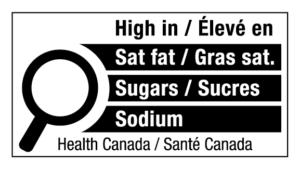Nutritional Expertise
Consumers are becoming increasingly interested in the quality of foods they eat. They regularly consult Nutrition Facts tables and expect that the values declared on the labels be representative of the actual nutritional composition of the product and that the value-added claims highlighting the product’s nutritional qualities be truthful. Who other than a nutritionist could best handle nutritional labelling? Since 1990, ACC Label’s nutritionists have provided the following professional nutritional services:
|
 |
Nutritional Analysis
Responsibility
Food manufacturers are responsible for:
- accurately presenting the composition of the foods they make, while taking into account the natural variability of nutrients in foods and the production process;
- choosing a suitable analysis method for the product.
Analysis Methods
The nutritional composition of a product, i.e. its energy value (Calories) and nutrient content (protein, fat, carbohydrates, vitamins and minerals), may be determined by either:
- Laboratory Analysis or
- Database Analysis
ACC Label offers advice regarding the most appropriate nutritional analysis method, considering the nature of the product and the client’s objectives. Sometimes, a combination of the two methods is recommended.
How to verify whether a laboratory is accredited?
|
Laboratory Nutritional Analysis
In laboratories, food chemists or lab technicians chemically decompose food products to determine their nutrient content. These analyses most accurately reflect the actual product composition. Laboratory analyses are particularly recommended when:
- a product contains several complex ingredients;
- it is difficult to determine the exact recipe yield;
- the product undergoes processing that alters its nutritional value, such as fermentation, germination and some cooking methods, such as deep fat frying.
ACC Label is a team of nutritionists. We do not have chemists on our team, nor do we have a chemical laboratory. However, when our nutritionists determine that a laboratory analysis is the best method for your products, they can direct you to laboratories accredited for nutritional labelling.
ACC Label generally recommends that nutritional analyses of food products be carried out by a reputable laboratory accredited according to ISO 17025 standards by the Standards Council of Canada because the results obtained this way most accurately reflect the actual product composition.
Database Nutritional Analysis
This method consists of a series of computations based on the product’s written recipe and the nutrient contribution of each ingredient. Unlike laboratory analysis, which is carried out on the product itself, database analysis is based on the recipe.
Database nutritional analysis is not a professional activity reserved to dietitians and nutritionists belonging to a professional body. However, the educational background of nutritionists, especially those specialized in nutritional analysis, is a major asset to achieve reliable results. With their food labelling expertise, ACC Label’s nutritionists are particularly qualified to conduct database nutritional analyses and address your nutritional labelling needs.
|
Basic requirements for database nutritional analysis ▪ ▪ ▪ ▪ ▪ ▪ ▪ ▪ ▪ ▪ ▪ ▪ |
For reliable results, the analysis should be based on a standardized recipe, i.e. one in which:
The less specific the ingredient data, the greater the margin of error. Even simple ingredients require precise descriptions. For example:
It is therefore important to provide the technical data sheets for the ingredients used. 2. the amount of each ingredient must be provided in metric weight (g or kg) or as a percentage by weight. Even liquid or powder ingredients must be supplied by weight rather than volume. Due to their different density, a cup of water does not have the same weight as a cup of oil or flour. 3. the cooking and processing methods must be described with accuracy; 4. the precise recipe yield is provided, i.e. the exact amount of product obtained after processing/cooking. |
Nutrition Facts Table and Nutrition Symbol |
||
|---|---|---|
 |
Once a product is analyzed (in a laboratory or by database), the results obtained are used to prepare the Nutrition Facts table and Nutrition Symbol according to the regulatory requirements.
To ensure all graphic requirements are respected, ACC Label provides the Nutrition Facts table and/or nutrition symbol in print-ready Encapsulated PostScript format (EPS file). Thus, your graphic artist can simply insert the Nutrition Facts table directly into the label artwork without worrying about the numerous typographical requirements. |
Why a nutrition symbol? What impact could it have on public health?
Find out more on our blog Mandatory Front-of-Pack |
Nutrient-Content or Health-Related Claims
The regulations allow manufacturers to make several types of claims about their products. Nutrient-content or diet-related health claims highlight the food product’s nutritional qualities to attract consumer attention. For example:
Nutrient-Content Claims
describe the amount of nutrients in the product. For example:
- Source of X essential nutrients
- No … (e.g.: fat, cholesterol, sodium, …)
Function Claims
relate the effects that a food has on normal body functions. For example:
- Consumption of 1 cup of green tea increases antioxidant capacity in the blood.
- Barley fibre helps lower cholesterol
Nutrient Function Claims
explain the role of specific nutrients contained in the product, such as:
- Calcium aids in the formation and maintenance of bones and teeth
- Vitamin E, a dietary antioxidant
Disease Risk Reduction Claims
linki a food or nutrient to a reduced risk of developing a diet-related disease or condition in the context of the total diet. For example:
- A healthy diet low in saturated and trans fats may reduce the risk of heart disease.
- A healthy diet rich in a variety of vegetables and fruit may help reduce the risk of some types of cancer.
- Non-cariogenic.
The regulations also allow other types of claims: quantitative and comparative nutrient-content claims, probiotic claims, weight maintenance claims, Canada’s Food Guide servings claims, etc.
Of course, each claim is subject to several conditions prescribed in the Food and Drug Regulations. ACC Label takes a weight off your shoulders by:
- Identifying the nutritional qualities of your products;
- Verifying the qualifying conditions for the claims considered for your product;
- Proposing claims and formulating them adequately, in French and in English;
- Including any disclaimer required and triggered by the claim.

